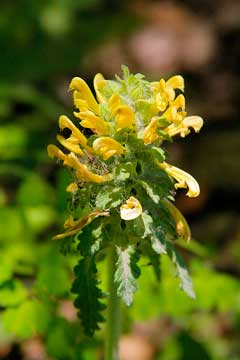 |
|
www.flickr.com/photos/8583446@N05 |
 |
|
Translate this page:
Summary
Physical Characteristics

 Pedicularis canadensis is a PERENNIAL growing to 0.4 m (1ft 4in).
Pedicularis canadensis is a PERENNIAL growing to 0.4 m (1ft 4in).
See above for USDA hardiness. It is hardy to UK zone 3. It is in flower from July to August. The species is hermaphrodite (has both male and female organs).
Suitable for: light (sandy) and medium (loamy) soils and prefers well-drained soil. Suitable pH: mildly acid, neutral and basic (mildly alkaline) soils. It can grow in semi-shade (light woodland) or no shade. It prefers moist soil.
UK Hardiness Map
US Hardiness Map
Synonyms
Plant Habitats
Woodland Garden Sunny Edge; Dappled Shade; Cultivated Beds;
Edible Uses
Edible Parts: Leaves
Edible Uses:
Leaves - cooked[105, 161, 177, 257].
References More on Edible Uses
Medicinal Uses
Plants For A Future can not take any responsibility for any adverse effects from the use of plants. Always seek advice from a professional before using a plant medicinally.
Antitumor Aphrodisiac Blood tonic Cardiac Poultice Stomachic
The roots are blood tonic, cardiac and stomachic[257]. A tea is used in the treatment of stomach aches, ulcers, diarrhoea, anaemia and heart troubles[222, 257]. A poultice of the root is applied to swellings, sore muscles and tumours[218, 257]. The finely grated roots were secretly added to food as an alleged aphrodisiac[222]. An infusion of the leaves has been used to procure an abortion[257]. An infusion of the fresh or dried leaves has been used to treat a sore throat[257].
References More on Medicinal Uses
The Bookshop: Edible Plant Books
Our Latest books on Perennial Plants For Food Forests and Permaculture Gardens in paperback or digital formats.

Edible Tropical Plants
Food Forest Plants for Hotter Conditions: 250+ Plants For Tropical Food Forests & Permaculture Gardens.
More

Edible Temperate Plants
Plants for Your Food Forest: 500 Plants for Temperate Food Forests & Permaculture Gardens.
More

More Books
PFAF have eight books available in paperback and digital formats. Browse the shop for more information.
Shop Now
Other Uses
References More on Other Uses
Cultivation details
A semi-parasitic plant, growing on grass roots. Rather difficult to establish in cultivation, it is best grown in conditions that approximate to its native habitat[200]. It requires a moist peaty soil and the presence of host grasses[1]. The plant is said to parasitize at least 80 different species in 35 different genera[274]. Requires a partially shaded to sunny site in a well-drained gritty but moist soil[200].
References Carbon Farming Information and Carbon Sequestration Information
Temperature Converter
Type a value in the Celsius field to convert the value to Fahrenheit:
Fahrenheit:
The PFAF Bookshop
Plants For A Future have a number of books available in paperback and digital form. Book titles include Edible Plants, Edible Perennials, Edible Trees,Edible Shrubs, Woodland Gardening, and Temperate Food Forest Plants. Our new book is Food Forest Plants For Hotter Conditions (Tropical and Sub-Tropical).
Shop Now
Plant Propagation
Seed - sow in pots of turf collected from the proximity of wild colonies or sow directly onto the sites where the plants are to remain[200]. Division of established plants might be possible in the spring. Establish the divisions near the parent plants[200]
Other Names
If available other names are mentioned here
Native Range
NORTHERN AMERICA: Canada (Québec (south), Ontario (south), New Brunswick (Charlotte Co.), Manitoba (south)), United States (Connecticut, Indiana, Maine, Massachusetts, Michigan, New Hampshire, New Jersey, New York, Ohio, Pennsylvania, Rhode Island, Vermont, West Virginia, Iowa, Kansas (east), Minnesota, Missouri, Nebraska (east), North Dakota (east), South Dakota (east), Illinois, Oklahoma (east), Wisconsin, Colorado (east-central), Alabama, Arkansas, Delaware, Florida, Georgia, Kentucky, Louisiana, Maryland, Mississippi, North Carolina, South Carolina, Tennessee, Virginia, New Mexico (north), Texas)
Weed Potential
Right plant wrong place. We are currently updating this section.
Please note that a plant may be invasive in one area but may not in your area so it's worth checking.
Conservation Status
IUCN Red List of Threatened Plants Status :

Growth: S = slow M = medium F = fast. Soil: L = light (sandy) M = medium H = heavy (clay). pH: A = acid N = neutral B = basic (alkaline). Shade: F = full shade S = semi-shade N = no shade. Moisture: D = dry M = Moist We = wet Wa = water.
Now available:
Food Forest Plants for Mediterranean Conditions
350+ Perennial Plants For Mediterranean and Drier Food Forests and Permaculture Gardens.
[Paperback and eBook]
This is the third in Plants For A Future's series of plant guides for food forests tailored to
specific climate zones. Following volumes on temperate and tropical ecosystems, this book focuses
on species suited to Mediterranean conditions—regions with hot, dry summers and cool, wet winters,
often facing the added challenge of climate change.
Read More
Expert comment
Author
L.
Botanical References
43200235
Links / References
For a list of references used on this page please go here
Readers comment
| Add a comment |
|
If you have important information about this plant that may help other users please add a comment or link below. Only comments or links that are felt to be directly relevant to a plant will be included. If you think a comment/link or information contained on this page is inaccurate or misleading we would welcome your feedback at [email protected]. If you have questions about a plant please use the Forum on this website as we do not have the resources to answer questions ourselves.
* Please note: the comments by website users are not necessarily those held by PFAF and may give misleading or inaccurate information.
To leave a comment please Register or login here All comments need to be approved so will not appear immediately.
|
Subject : Pedicularis canadensis
|
|
|
|